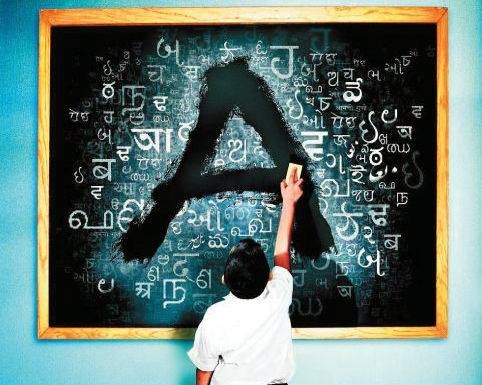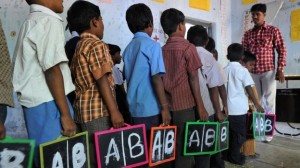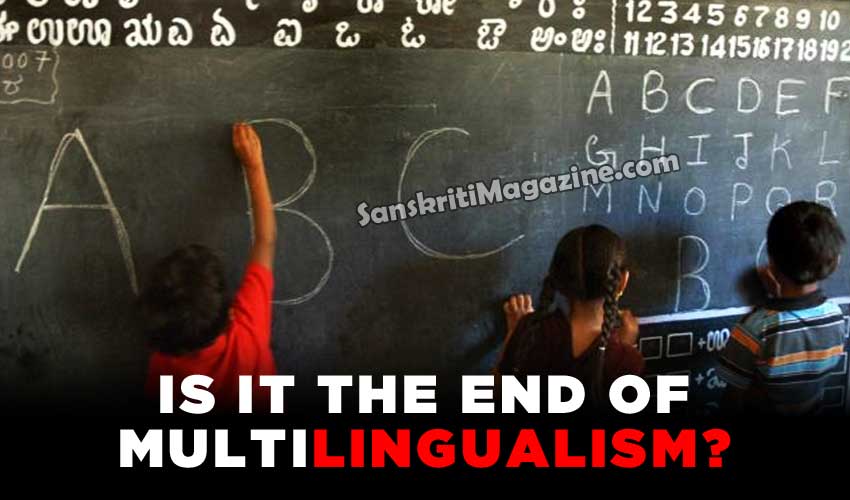In India, the traditional language dialogue have largely centred on the conflict between Indo-European and Dravidian languages, but recently the focus has been more on English vs. Indian languages. This is an indication that a counter narrative has already emerged from the traditional Hindi-English conflict to a more serious plea to preserve Indian languages.
However, it took almost 67 years of post-independence to get over the Hindi-Tamil phobia that was instilled in our mind by our politicians and start a debate on the serious threat that English poses to our local languages. Globally, there is a serious concern among linguists and language lovers about the spread of English which has resulted in categorizing many of the worlds’ minority languages as endangered languages.
Are we unreasonable in our judgement towards the dominance of English over Indian languages?
In this globalised world where the knowledge of English is essential, is talking about linguistic diversity a seriously futile act?
I will try to answer these questions by explaining the nature of India’s linguistic diversity, the reasons why we failed to acknowledge it and why promoting mother tongue education is so important in maintaining the nation’s linguistic plurality.
India – the land of linguistic diversity
India is considered to be one of the top 25 mega diverse countries with the four distinct language families Indo-Aryan, Dravidian, Austro-Asiatic and Tibeto-Burman. The 1961 census recognizes almost 1652 mother tongues in India. Five of our languages are bestowed with classical language status—Kannada, Tamil, Telugu, Sanskrit and Malayalam. Among the 22 scheduled languages, the more recent 2001 census lists Hindi as the most spoken language (41.03%) and Bodo (0.13%) and Sanskrit (14,135 speakers) as the least spoken languages. Despite the prevalence of such rich linguistic diversity, we have consistently failed to recognize the presence of heritage languages and have instead favoured English immensely to the extent that it has now taken on our linguistic diversity. For years, favouring English has continued, however, started getting alarmed until when UNESCO has recognized 198 minority languages under the endangered list.
Views against language diversity-Import of western thought mixed with colonial hangover
The colonial legacy has always encouraged us to become the consumers of anglo-centric approaches. These approaches had a limited understanding of language diversity as they were often viewed from the prism of immigration and immigrant bilingualism. Diversity is often treated as random variation that encourages a monolingual way of looking at life rather than promoting multilingualism. The earlier western models on language diversity/multilingualism were mainly built on the evidence provided by research psychologists who proposed that bi/multilingualism was disadvantageous and harmful to individuals, especially children, growing up in a multilingual environment.
Appallingly, these researchers went one step further suggesting that bilingual children performed comparatively lower on intelligence tests and were at the risk of a language or an intellectual handicapcompared to monolingual children. In other words, psychological research findings prior to the 1950s have shaped the idea that linguistic diversity is harmful and children growing up in such environments may well turn into perfect imbeciles. Of course, there were significant shortcomings in these “monolingual superiority” findings with the most significant one being that the studies participant groups were poorly controlled for in regard to major factors such as socio economic status (SES).
 For example, in the USA and UK, where most of these studies were conducted, the monolingual children came from a higher SES than the bilingual children. With SES being such a critical indicator for overall language and cognitive development, these researchers carefully ignored this potential confound, leading to seriously misleading results that had significant implications in shaping the language policy. The origins of this superiority theory can be clearly traced when we realize that the monolinguals who participated in the study were English speaking children, and therefore such views were often coupled with inherent racist feelings against immigrant bilinguals and bilingualism.
For example, in the USA and UK, where most of these studies were conducted, the monolingual children came from a higher SES than the bilingual children. With SES being such a critical indicator for overall language and cognitive development, these researchers carefully ignored this potential confound, leading to seriously misleading results that had significant implications in shaping the language policy. The origins of this superiority theory can be clearly traced when we realize that the monolinguals who participated in the study were English speaking children, and therefore such views were often coupled with inherent racist feelings against immigrant bilinguals and bilingualism.
The idea that linguistic diversity was harmful later became a subject of criticism. However, the superiority theory of English monolingualism triumphed over this and was successfully adopted by countries like India. In a country that still had the remnants of colonialism and English imperialism, we happily accepted such stories ignoring the fact that generations have grown up here in a natural bi/multilingual environment. Our politicians were busy in engaging language wars and treated indigenous languages as a medium to divide people from different linguistic communities to garner votes.
Even today the story has rarelychanged, with English holding the status of a prestigious language and speaking proficiency in English is noted as a crucial factor for upper class social acceptability. There is a tendency to view English as the language of modernity and sophistication whereas local languages are considered to be less evolved and prestigious. This view is particularly alarming and dangerous given the fact that language might have evolved for purposes beyond communication. The cognitive, social and cultural development of an individual is inherently tied to language acquisition. Failing to understand the purpose of languages from a socio-cultural-linguistic viewpoint will result in favouring of a particular language and a lack of respect to indigenous languages. This prejudiced way of looking at language can be equated to the earlier views of western academics that possessed a phobia towards bilingualism or other languages apart from English.
If we need to preserve the sub continental legacy of linguistic diversity, we must abandon such anglo-centric views and build indigenous language models that will foster an environment which is conducive for taking the diversity and its research forward. Many of our languages are at risk of becoming extinct, due to the faulty approaches that we adopted. Our western educated intellectuals need to abandon the negative attitudes that they hold against our languages. Such hostility will only devalue the role of indigenous languages in shaping the linguistic pluralism.
Why bother so much about linguistic diversity?
By any standard of available evidence, linguistic diversity is now treated as a rule and not an aberration. Humans have evolved to learn many languages, and therefore living in a linguistically diverse environment expands their mental capacity rather than limiting it. Research conducted in the past decade gave an increasingly better understanding about what linguistic diversity can offer to people living in diverse environment. Empirical evidence has gathered enough evidence to suggest a ‘cognitive advantage‘ for bilinguals who are proficient in more than one language.
The majority of the evidence supports the fact the being bilingual makes an individual better at cognitive tasks such as selective attention andinhibitory control. This means that people who grow up in a diverse linguistic environment are much better than monolingual individuals on certain specific cognitive skills, like attention and problem solving. Note that such skills are critical for day to day activities that enrich our life experiences. These skills emerge from childhood as a result of the early experience with two languages, may continue to persist into adulthood, and could possibly delay the onset of Alzheimer disease for at least 4 years.
Surely, these results can have positive implications for most of the Indians living in a diverse linguistic terrain. Like any other life experiences, a diverse linguistic experience is naturally enriching and has proven to have excellent benefits, providing evidence that is contrary to promoting only mono-lingualism. Therefore,it is important for us to treat linguistic diversity as an asset and not a liability.
Diversity is sustained only through English-Breaking the myth
In India, the story of diversity is also misinformed by the excessive importance given to English bilingualism. The story is that linguistic diversity or bi/multilingualism is a very recent urban phenomenon as a result of globalization. The idea that diversity can exist only in the presence of a contact language such as English is not true. Diversity by no means is sustained only by English as a second language. This view may underestimate the role of linguistically diverse ancient societies in sustaining bi-culturalism and bi/multilingualism.
Take for example, Kasargod, the northern district of Kerala which is one of the most linguistically diverse environments. The people living in this area are exposed to seven different languages: Kannada, Malayalam, Tulu, Konkani, Beary, Marathi, Hindi and Urdu. It is true that English has contributed immensely to bilingualism but this is not always the case. In rural Kasargod or in urban Bangalore, languages like Tamil and Hindi have helped enormously in shaping the city’s linguistic plurality.
Promoting English monolingualism promotes science (?)
The general perception is that English is the language of science and hence one may prefer English over Indian languages. It is true that most of the scientific articles are written in English and also most respected journals in any field are published in English. However, this is not a good reason for a country like India to favour English.
The long standing colonial legacy may have given us better English language proficiency than the Chinese, but in reality we have not translated this upper edge into our higher education and research. None of the Indian universities have found a place in the top 200 university rankings based on the times higher education university rankings, whereas the Chinese universities of Peking (overall score 70.7) and Tsinghua (overall score 67.1) ranked 46 and 52 respectively.
If it is just a matter of scientific writing in English then our universities should be way ahead of any other Asian universities, but unfortunately the real problem seems to have been tied up with factors other than English language proficiency. Therefore, the logic that favouring English because it acts as a language of science is not good enough to promote English monolingualism in an Indian context.
 Not anti-English
Not anti-English
A plea for sustaining diversity is not a reflection of language jingoism but must be taken as a serious concern for preserving the heritage languages. This is not to say that we must underestimate the role of English. The fact that I write this article in English itself suggests the importance of it in connecting our different linguistic communities. Language diversity is like different coloured beads in a chain and English has definitely shaped India’s future by linking those beads in a single thread.However in reality, we cannot afford to have India as a nation of linguistic half-castes.
Any educational policy that discredits the role of mother tongue education is essentially creating a generation with confused identity that is completely disconnected from the real life cultural reality. Most of the studies have shown that acquisition of literacy skills in a mother tongue will help in transferring the knowledge to a second language and even to a third language. It is extremely distressing to see the excessive burden that is placed on our children to learn English at such young age that results in a natural suppression of the home language.
The child gets fewer opportunities for communication especially with grandparents or even with parents as a result of mother tongue suppression at home. Although the present bi/trilingual education in India has enormous shortcomings, encouraging bilingual education seems to be an ideal policy. Discussing the shortcomings of our bilingual education is beyond the scope of this article but we can always start bilingual education at home and not wait until the government implements the right policy.
It is important to make every single person understand the benefits of language diversity especially to the urban paranoid parents who need to be convinced that bilingual children are a great asset to the nation. Bi/Multilingualism is now considered as a primary human condition and we can only sustain the primordial phenomenon through our children. Giving classical language status, creating academic post in central universities and allotting 100 crores is not going to help our ailing languages. Instead, creating awareness about the advantages of bi/multilingualism is what will help in nourishing the language diversity.
Taking diversity forward-The future
It is a good sign that the counter narrative I mentioned at the beginning of this article has already started. However, we need to go a long way inpreserving, documenting and digitizing our language data, and equipping our children to be bilinguals or multilinguals by learning their mother tongue and sustaining language diversity through a healthy relationship between English and Indian languages. In India, we have carried on the vision of Macaulay and have produced generations of his children and great grandchildren. The need of the hour is to create a generation that can Indianise English or ‘chutnify’ the English language.
~By Vinshu Nair
Vishnu Nair is a PhD student at Macquarie University, Sydney. He is working on the cognitive consequences of language diversity











